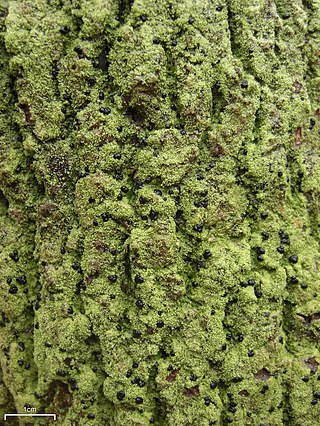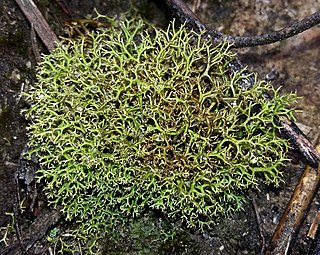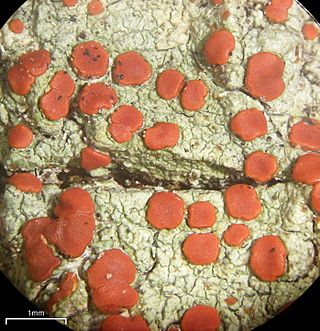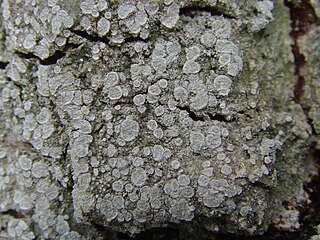
Bacidia is a genus of lichen-forming fungi in the family Ramalinaceae. The genus was circumscribed by Giuseppe De Notaris in 1846. Species in the genus are crust-like lichens with stemless apothecia; they have green algae (chloroccoid) as photobionts. Their asci have 8 colorless, cylindrical to acicular, multiseptate spores, with curved and thread-like conidia.

Ochrolechia is a genus of crustose lichens in the family Ochrolechiaceae.

Cladia is a genus of lichenized fungi in the family Cladoniaceae. Cladia species have a crustose primary thallus and a fruticose, secondary thallus, often referred to as pseudopodetium. The type species of the genus, Cladia aggregata, is widely distributed, occurring from South America, South Africa, Australasia and South-East Asia to southern Japan and India. Most of the other species are found in the Southern Hemisphere.

Cliostomum is a genus of lichenized fungi in the family Ramalinaceae. It has about 25 species.

Lecania is a genus of lichenized fungi in the family Ramalinaceae. The genus was circumscribed by Abramo Bartolommeo Massalongo in 1853. Lecania is widely distributed, especially in temperate regions, and contains about 64 species.

Porina is a genus of lichens in the family Trichotheliaceae. A 2020 estimate places about 145 species in the widespread genus.

Amandinea is a genus of lichenized fungi in the family Caliciaceae. Genetic studies indicates that the genus Amandinea and Buellia are the same, although this is not widely accepted.

Thelidium is a genus of lichen-forming fungi in the family Verrucariaceae. The genus was circumscribed in 1855 by Italian lichenologist Abramo Bartolommeo Massalongo, who assigned Thelidium amylaceum as the type species.

Ramboldia is a genus of lichen-forming fungi in the family Ramboldiaceae. The genus was circumscribed in 1994 by Gintaras Kantvilas and John Alan Elix. It was emended in 2008 by the inclusion of Pyrrhospora species containing the anthraquinone russulone in their apothecia and having a prosoplectenchymatous exciple. The family Ramboldiaceae was circumscribed in 2014 to contain the genus.

Rhizocarpon is a genus of crustose, saxicolous, lecideoid lichens in the family Rhizocarpaceae. The genus is common in arctic-alpine environments, but also occurs throughout temperate, subtropical, and even tropical regions. They are commonly known as map lichens because of the prothallus forming border-like bands between colonies in some species, like the common map lichen.

Tephromela is a genus of lichens in the family Tephromelataceae. There are about 25 species in this widespread genus.

Catillaria is a genus of crustose lichens in the family Catillariaceae. The genus was circumscribed by Italian lichenologist Abramo Bartolommeo Massalongo in 1852. It is the type genus of Catillariaceae, which was circumscribed by Austrian lichenologist Josef Hafellner in 1984.

Lepra is a genus of lichen-forming fungi in the family Pertusariaceae. Although the genus was created in 1777, it was not regularly used until it was resurrected in 2016 following molecular phylogenetic analyses. It has more than 80 species, most of which were previously classified in genus Pertusaria.












